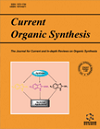- Home
- A-Z Publications
- Current Organic Synthesis
- Previous Issues
- Volume 19, Issue 3, 2022
Current Organic Synthesis - Volume 19, Issue 3, 2022
Volume 19, Issue 3, 2022
-
-
Selenocyclization by Formation of Carbon-nitrogen Bonds
More LessAuthors: Biljana Šmit, Petar B. Stanić and Nenad JankovićSelenium promoted-cyclization of unsaturated substrates containing internal nitrogen nucleophiles, such as different amines and amides, including the examples of its application in the synthesis of more complex polycyclic compounds is reviewed. Selenocyclization reactions of some more specific polyfunctional substrates, like Biginelli hybrids and hydantoins, are also covered.
-
-
-
Diselenides and Selenocyanates as Versatile Precursors for the Synthesis of Pharmaceutically Relevant Compounds
More LessAuthors: Marina D. Kostić and Vera M. DivacOrganoselenium chemistry has undergone extensive development during the past decades, mostly due to the unique chemical properties of organoselenium compounds that have been widely explored in a number of synthetic transformations, as well as due to the interesting biological properties of these compounds. Diselenides and selenocyanates constitute the promising classes of organoselenium compounds that po Read More
-
-
-
Selenium as a Versatile Reagent in Organic Synthesis: More than Allylic Oxidation
More LessAuthors: Samuel Thurow, Laura Abenante, João M. Anghinoni and Eder João LenardãoFor many years since its discovery, Selenium has played the role of a bad boy who became a hero in organic transformations. Selenium dioxide, for instance, is one of the most remembered reagents in allylic oxidations, having been applied in the synthesis of several naturally occurring products. The main goal of this review is to show the recent advances in the use of classical and new selenium reagents in organic synthesis. As d Read More
-
-
-
A Review on the Role of Transition Metals in Selenylation Reactions
More LessAuthors: Rasmi V. Morajkar, Adarsh P. Fatrekar, Abhijeet Mohanty and Amit A. VernekarOrganoselenium chemistry has emerged as a distinctive area of research with tremendous utility in the synthesis of biologically and pharmaceutically active molecules. Significant synthetic approaches have been made for the construction of C-Se bonds, which are useful in other organic transformations. This review focuses on the versatility of transition metal-mediated selenylation reactions, providing insights int Read More
-
-
-
Recent Advances in Organoselenium Catalysis
More LessAuthors: Santosh G., Samata E. Shetgaonkar and Fateh V. SinghOrganoselenium chemistry has developed as an important tool in the field of synthetic and medicinal chemistry. Various organoselenium reagents have been developed and used successfully to achieve different organic transformations such as selenocyclizations, oxyselenenylations, selenoxide eliminations, etc. Additionally, organoselenium reagents' potential is not limited to their use as stoichiometric reagents, but they have be Read More
-
-
-
Conversion of Limonene over Heterogeneous Catalysis: An Overview
More LessAuthors: Ravi Tomar, Swati Jain, Purnima Yadav, Tanima Bajaj, Fatemeh Mohajer and Ghodsi M. ZiaraniThe natural terpene limonene is widely found in nature. The (R)-limonene (the most abundant enantiomer) is present in the essential oils of lemon, orange, and other citrus fruits, while the (S)- limonene is found in peppermint and the racemate in turpentine oil. Limonene is a low-cost, low toxicity biodegradable terpene present in agricultural wastes derived from citrus peels. The products obtained from the conversion of li Read More
-
-
-
Recent Advances in the Green Synthesis of Heterocycles: From Building Blocks to Biologically Active Compounds
More LessAuthors: Christian Schäfer, Hyejin Cho, Bernadett Vlocskó, Guoshu Xie and Béla TörökRecent advances in the environmentally benign synthesis of common heterocycles are described. This account features three main parts; the preparation of non-aromatic heterocycles, one-ring aromatic heterocycles and their condensed analogs. Due to the great variety of and high interest in these compounds, this work focuses on providing representative examples of the preparation of the target compounds.
-
-
-
Synthesis and Liquid Crystalline Properties of Low Molecular Weight Bis- Chalcone Compounds
More LessAuthors: Anju K. Sasidharan, Jomon Mathew, Ammathnadu S. Achalkumar and Manoj MathewsAims: In this paper, we report on the synthesis and liquid crystalline properties of some low molecular weight bis-chalcone compounds derived from acetone, cyclopentanone and cyclohexanone mesogenic cores. Background: Structurally bis-chalcones belong to a broader family of chalcone compounds. Chalcone is a compound that consists of two aromatic rings linked by an unsaturated α, β-ketone. Objective: Liquid crystalli Read More
-
Volumes & issues
-
Volume 22 (2025)
-
Volume 21 (2024)
-
Volume 20 (2023)
-
Volume 19 (2022)
-
Volume 18 (2021)
-
Volume 17 (2020)
-
Volume 16 (2019)
-
Volume 15 (2018)
-
Volume 14 (2017)
-
Volume 13 (2016)
-
Volume 12 (2015)
-
Volume 11 (2014)
-
Volume 10 (2013)
-
Volume 9 (2012)
-
Volume 8 (2011)
-
Volume 7 (2010)
-
Volume 6 (2009)
-
Volume 5 (2008)
-
Volume 4 (2007)
-
Volume 3 (2006)
-
Volume 2 (2005)
-
Volume 1 (2004)
Most Read This Month
Article
content/journals/cos
Journal
10
5
false
en


